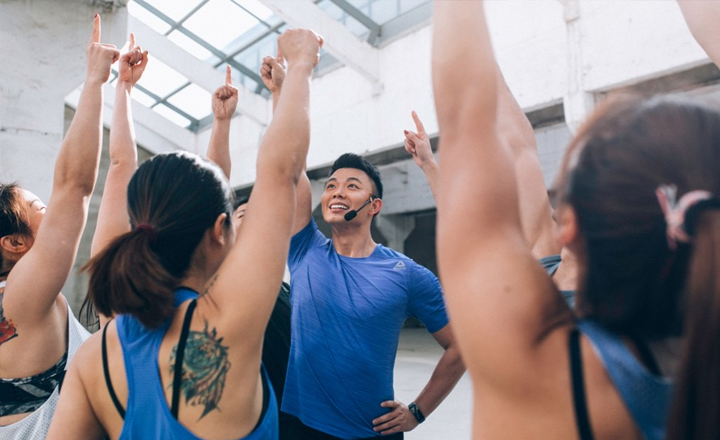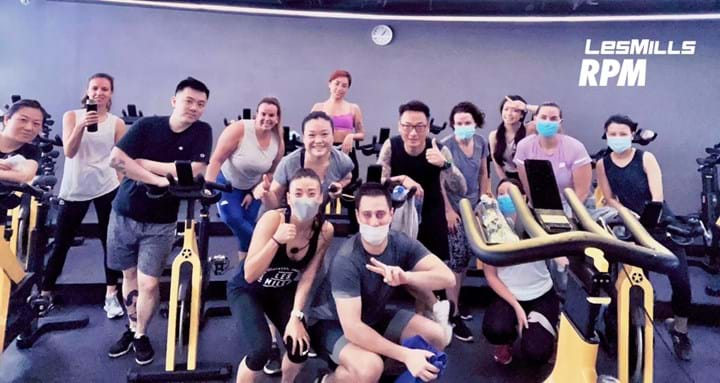In the wake of a global health pandemic, supporting people back into their usual fitness routines poses a range of challenges, as well as uncertainties around which activities are safe to do and when.
One thing that is certain is that continued physical inactivity will bring catastrophic consequences for our physical and mental health, the economy, and the environment. In the US alone, chronic diseases that can be prevented by regular exercise, are projected to cost US$42 trillion between 2016 and 2030.
COVID-19 has brought great progress in the range of options for people to stay active at home, but motivation remains the key to regular exercise and this is the very reason our industry exists. No one owns the patent to the press up, and there’s no finer treadmill than the great outdoors, yet gym members are on average 14 times more active than non-members.
People need motivation to stay active and that’s why it’s so important for health clubs – and all the things that make them inspiring – to reopen as soon as safely possible. In terms of group fitness, we know live classes are one of the most powerful forms of motivation, and the numbers bear this out.
Members who attend group fitness classes visit their facility 4 times per week (compared to IHRSA’s industry average figure of 1.9 member visits per week). Those who do 3+ Les Mills classes per week stay members of their club 50% longer than those who don’t do classes – that’s an extra 9.8 months per member (Qualtrics, 2019). Furthermore, group fitness attendees recommend their gym to 18% more people than gym-only members, while 10% of group fitness attendees recommend to 10+ non-members.
Put simply, group fitness members are among the most valuable type of customer you can have. By staying longer and pulling in more new members, group fitness members form the bedrock of a successful club. So in the face of uncertainty, how do you set about bringing your studio back into action safely and quickly? Here are six tips for getting on the front foot with your group fitness offering post-lockdown.
1. Smart social distancing
With social distancing likely to be in place for many months to come, optimising space in and around your club is essential for getting members back into group workouts – particularly when gym floor capacity is greatly reduced. This requires an agile mindset and a willingness to adapt. For example, some relaunched clubs are running group exercise classes on basketball courts, training fields, and even car parks.
The key for clubs is to crunch the numbers around studio size and their local social distancing requirements to right-size class capacity. In the US, Crunch Fitness is using tape to create ‘grids’ on its studio floors to ensure members maintain a safe distance during group fitness classes, while some clubs in China have taken a phased approach to class introduction.
“With many clubs now open for over a month, we’re really starting to see group fitness come back strongly,” says Les Mills China CEO Jane Jiang, who has been working closely with 1,400 Chinese clubs to help bring their group fitness studios back into actions.
“Clubs started with group cycling programs because the bikes ensure people are fixed in position, with adequate space. Classes like BODYPUMP™ and CXWORX™ are also doing well as there isn’t any need for participants to move from their station, whereas classes that comprise a lot of running around require a little more consideration. But gradually we’re starting to see the higher intensity classes like BODYCOMBAT™ coming back as well. What’s been clear is that participants are delighted to be back in the classes and sharing a social experience.”

2. Managing bookings
With clubs operating at reduced capacity, time and space are at a premium, so it’s vital to optimise your club’s footfall. This requires a well-thought-out booking system which is reliable and gives everyone a fair amount of club access. It also means getting the right balance between continuing to service digital demand for your online workout offerings, while tapering this to drive people back towards the physical club.
“Members will like being able to plan again and schedule things in, so make sure it’s easy for them to book classes so they can get a sense of routine and control back in their life,” advises Styles Studios Fitness Co-Owner and IHRSA Board Member Carrie Kepple.
Virtual fitness in your studio is also a great solution for optimising your club capacity and providing cost-effective group fitness all day if your class numbers can’t justify the cost of an Instructor. Find out more about Virtual today.
3. High-quality hygiene measures
With hygiene regulations and industry standards varying widely by market, official guidelines should be the first port of call for every club, as well as any additional steps you can take to emphasise the safety of your studio. Beyond this, there are many practical examples from reopened clubs around the world worth considering, including cleaning regimes, ample signage, and one-way systems in-club to mitigate the risk of transmission.
At Will’s Gym (operator of 170 premium clubs in China) the in-club radio system supports safety measures by explaining the social distancing and hygiene rules every 30 minutes – a message reiterated by trainers.
Meanwhile, Les Mills New Zealand clubs are asking members to bring full drinks bottles and towels (mandatory) to reduce the chance of transmission via equipment or fountains, plus any portable class equipment they require, like boxing gloves or mats.
Group fitness timetables in many markets have been recalibrated to allow a minimum of 15-minute between each class for necessary cleaning of surfaces and fitness equipment, as well as to prevent crowds from forming outside the studio in between classes.
And trade organisations (such as IHRSA and EuropeActive) have issued extensive guidelines for clubs, including advice to remove all communal equipment that absorbs sweat, such as yoga mats or foam rollers, and insist that members bring their own.
4. Reimagining the member experience
Meeting local government and industry guidelines on safety is clearly the top priority for every club, but there are many additional tweaks to the member experience that operators can make to reassure that it’s safe to return.
Under the premise that ‘perception is reality’, Asia-based premium operator Pure Group is visually reinforcing every step taken to keep members safe. Cleaning teams have been increased and positioned to always be in sight when members move around the club, while Pure is also going to great lengths to communicate the new hygiene measures to members via their app, social media, and notices in-club.
And while the science around the effectiveness of face masks in limiting spread of COVID-19 remains inconclusive, many countries and organisations are in favor of mask-wearing as a means of reassuring people that precautionary safety measures are in place. For gyms looking to allay the fears of anxious members, there’s a case for insisting on members and Instructors wearing masks in-club, at least for the early weeks. This was the situation in China, where masks were initially mandatory, though some clubs have since started to relax this policy.

5. Welcoming new fans
One outcome of COVID-19 lockdown has been the explosion of people taking up digital fitness offerings – and new findings suggest this could yield significant opportunities for clubs. Research from fitness facilities developer Alliance Leisure found that 69 per cent of consumers who were inactive before lockdown have since increased their exercise levels, while 96 per cent of those who tried a workout from a club during lockdown said they would use that facility post-lockdown..
With the potential for an influx of new members hungry for group workouts when your club reopens its doors, setting out a smooth path to onboard them is paramount..
Communicating the precautions and safety measures you’re putting in place, driving that sense of community, and dialing up the factors that attracted them to your club in the first place are the central pillars here. There’s also a role here for your team to use SMART START principles to help members acclimatise to your club, building workout frequency and intensity step-by-step.
6. Ramp-up the welcome for existing members too
Every club has a hardcore following, but not everyone will be back right away, so it’s important to be proactive across your club’s comms channels, highlighting that people are back in the gym and emphasising the message that it feels good to be back working out again. People have been in lockdown for a long time now and have been taught to fear social contact, so reassuring members that it’s safe to come back should also be a focus.
While much has changed, some principles remain the same. It’s our people who drive members to join clubs in the first place, and it’s our people who will be key to bringing them back once it’s time to reopen.
As well as the operational impact your team can make to get your club up and running, consider the significant emotional contribution they can make to help members feel safe again.
“Instructors hold the hearts of members more than anyone else in the club and this is needed now more than ever,” adds Carrie Kepple.
“These Instructors are often the types who will jump right back in and do whatever it takes to get members feeling good again. They’re likely to have lots of existing relationships with members and it’s also important to ensure they make a real effort to connect and engage with members they don’t know."
GETTING READY TO RELAUNCH YOUR CLUB?
Check out our Club Recovery Hub, packed with tools, insights and resources to help your club reopen with purpose and clarity.GET FIT FOR THE FUTURE

